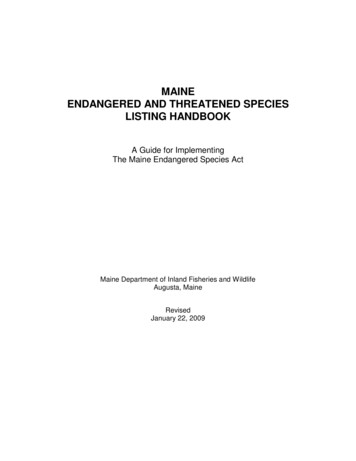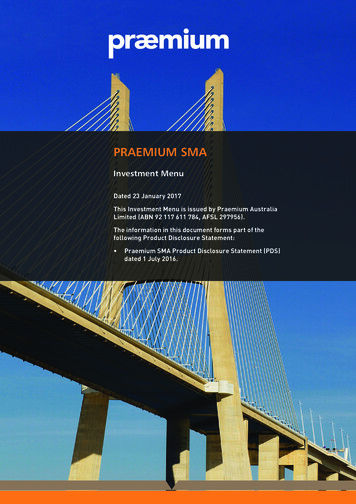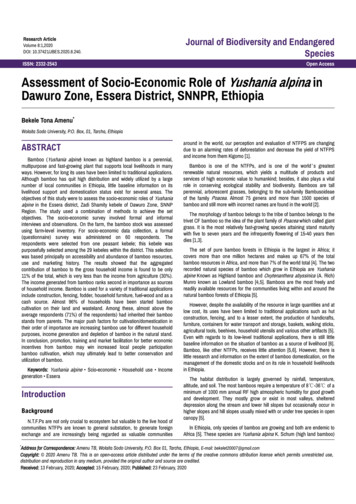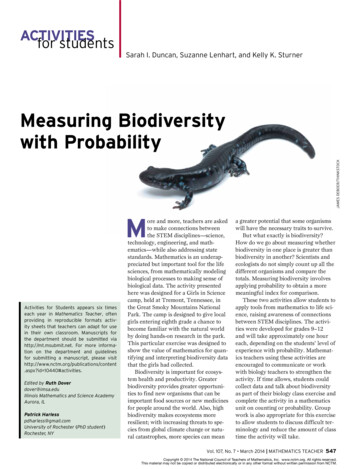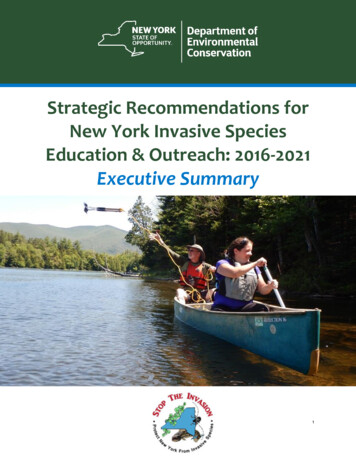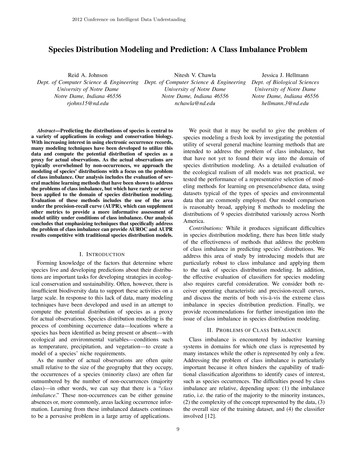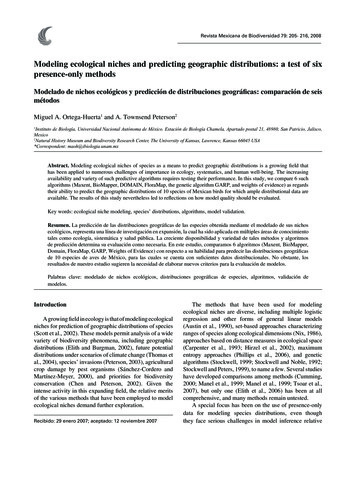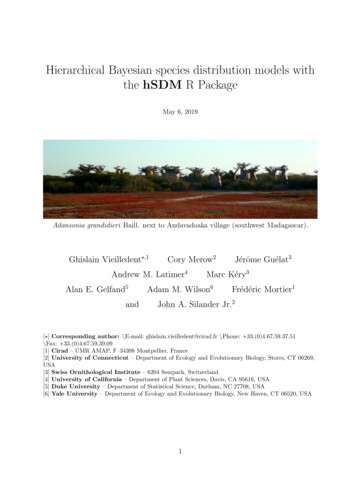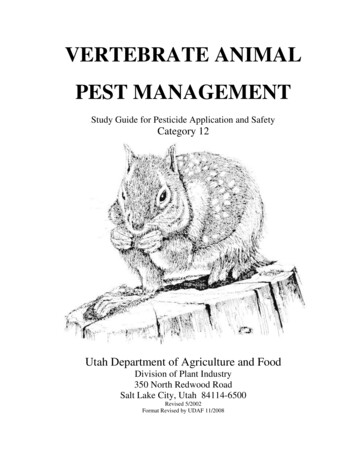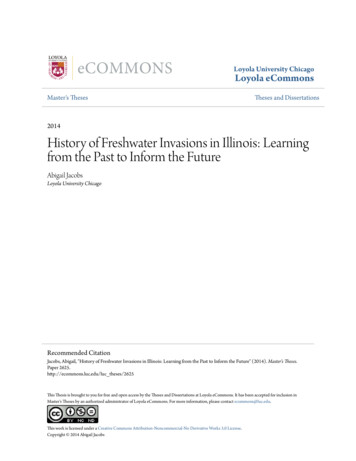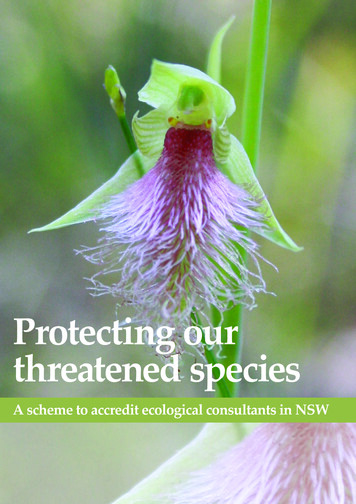
Transcription
Protecting ourthreatened speciesA scheme to accredit ecological consultants in NSW
ContentsAn accreditation scheme for ecological consultants3Why is it needed?3Missing species4Forgotten records6Over optimistic reports7Consultant shopping8Misleading advice8The proposed scheme explained9Why a mandatory scheme is essential10Summary10Contact us10Cover: How could you miss this beauty; one of severalorchid species said to be missing from a consultant’sreport at Wadalba for a development.2
An accreditation scheme for ecological consultantsNSW Greens MP, Cate Faehrmann, has introduced a bill to Parliament to establish anaccreditation scheme for ecological consultants. The Threatened Species ConservationAmendment (Ecological Consultants Accreditation Scheme) Bill 2011 will require ecologicalconsultants to undergo formal accreditation and include a mechanism to peer reviewecological assessments that come into dispute.Why is it needed?Ecological consultants are the professionals hired by developers and coal and gas companiesto prepare the environmental reports put forward to councils and planning ministers whenseeking approval for their housing developments and mines.Crucial development decisions impacting hundreds of thousands of hectares of bush,farmland and threatened species habitat are based on their work.Yet unlike many other professional services, such as plumbers, electricians, builders,conveyancers and property valuers, ecological consultants do not have to be licensed oraccredited.While many consultants act with integrity, questions have been raised about some ecologicalconsultants’ work for many years. There are numerous reports of ecological consultantstailoring their findings so as not to result in a ‘red flag’ for developers and miners.It is known that developers shop around for obliging consultants.There are concerns some consultants who have refused to bow to this pressure are slowlybeing forced out of the market. There is even a consultant whose qualifications are thoughtto have been purchased on the internet.This brochure cites a few prominent case studies to demonstrate the prevalence of theproblem and why the NSW Parliament needs to pass the Threatened Species ConservationAmendment (Ecological Consultant Accreditation Scheme) Bill 2011.3
Missing speciesCullen Valley Mine, Gardens of StoneSometimes threatened species can go unnoticed when consultants conduct site visits.A case in point is the nationally threatened Persoonia marginata missing from the FloraAssessment for Coalpac Pty Ltd for the company’s mining projects at Cullen Valley in BenBullen State Forest at the gateway to the magnificent Gardens of Stone.This raised suspicisions with conservationists who conducted their own flora assessmentand found that at least 75 species were missing from another report for the company.1The Office of Environment and Heritage subsequently confirmed that Persoonia marginatadoes occur within Coal Pac Pty Ltd’s Cullen Valley mining lease.Above: The nationallythreatened Persooniamarginata (Photo courtesyWiki-commons).Right: The Gardens ofStone (Photo courtesy BlueMountains ConservationSociety).4
Powerful owl, WadalbaLocal residents were aghast in November 2011 when a hillside at Wadalba was clear felledfor a development sanctioned by Wyong Shire Council. The Council professed surprisethat powerful owls, a threatened species, were found breeding on the site at the time of theclearing and lauded their efforts to relocate them.Local conservationists had long expressed frustration that the reports the ecologicalconsultants prepared for the developer and submitted to Council early in the approvalprocess missed over 100 species they had recorded on the site including a highlythreatened orchid that is endemic to the area and several other orchid species. Theyalso say the consultant failed to give proper acknowledgement that powerful owls werebreeding at the site.Following the clearing the future of the powerful owls is in doubt and only six of theoriginal 120 endemic orchids remain in Wyong Shire – and therefore the world.Powerful owl chicks andan adult photographed atWadalba (Photo courtesy BosBranwhite).West Menai Aboriginal land, South West SydneyAboriginal elder Uncle Max Dulumunmum Harrison, when protesting a development ofbushland at west Menai in South West Sydney, told the Daily Telegraph that the goannas,powerful owls and wallaby tracks he’d seen at the site:“.must be invisible because the other fellas that done the (environmental) survey saidthere was nothing here.” 25
Pine Dale Coal Mine, near LithgowIn its submission opposing the Yarraboldy extension to the Pine Dale Coal Mine, LithgowEnvironment Group states:“The Flora Assessment (for the project) . fails to provide even the most basicassessment of the vegetation types and floristic values that will be impacted upon”. 3Lithgow Environment Group has identified 106 plant species occurring within andaround the proposal area that are not identified in the consultant’s species list, includingthreatened, rare and indicator species for the endangered ecological community MontanePeatlands & Swamps listed under the Threatened Species Conservation Act. In just one shortwalk over the proposal area in September 2010, Lithgow Environment Group membersidentified the dominant shrub species to be ones that were not even mentioned in theFlora Assessment.Forgotten recordsCobaki housing development, Tweed ShireEcologist David Milledge criticises the assessment report for the controversial Cobakihousing development in the Tweed area on the far north coast of NSW for:“omitting reference to the 2006 study conducted by Peter Parker for the developer,which recorded the rufous bettong and longnosed potoroo on the site”and noting that“past records of koalas in the site also appear to have been ignored”. 4The Cobaki suburb has now been built, further dwindling the habitat for these threatenedspecies with Milledge concerned for their future in the Tweed area.A Longnosed potoroobeing released atCobaki.6
Over optimistic reportsBoggabri Coal Mine, Maules CreekThe Environmental Assessment (EA) for the expansion of the open cut Boggabri CoalMine in Leard State Forest has been roundly criticised by an alternative ecologicalconsultancy SoilFutures Consulting Pty Ltd hired by the Maules Creek CommunityCouncil. SoilFutures finds that the EA prepared by the consultant hired by the miningcompany Boggabri Coal Pty Ltd:“fails to deliver an understanding of the soils”and did not“interpret soil information for the purpose of mine rehabilitation adequately”.5Is this a genuine failure to understand the soil situation or an example of an overoptimistic claim that the land can be successfully rehabilitated after open cut coal mining?How many other coal companies do this?The open-cut Boggabri Coal Mine at Leards Forest.7
Consultant shoppingSouthern Highlands Shale WoodlandDevelopers shop around for helpful consultants. A clear example of this is found inStephen Garrett v Dennis Charles Williams [2006], a case of illegal clearing in the SouthernHighlands.In this case, the developer Dennis Williams first hired an ecological consultant, Mr Stone,who submitted a report advising that Mr William’s development:“.as proposed is likely to have a significant effect on the Southern Highlands ShaleWoodland Endangered Ecological Community.” 6The Judgement in the Land and Environment Court records Mr Williams then telling hissolicitor that “Mr Stone’s report is not what I want to put to Council. I am going to look foran alternative consultant”.The alternative consultant submitted a report to say the vegetation was only a ‘marginalor variant patch’ of the endangered ecological community. As CJ Preston notes in hisjudgement, Mr Williams obtained:“.another ecological consultant to support his development application after MrStone’s conclusions against the defendant’s interests.”. 6This only came to light because the developer went on to clear the ecological communityillegally and the matter ended up in court but the practice of consultant shopping isthought to be widespread.Misleading advicePort Stephens koalasKoalas fell victim to misleading advice in Plath v Fish and Plath v Orogen [2010]. Inthis case an ecological consultant and his company were actually convicted of causingdamage to koala habitat on a property at Taylors Beach, Port Stephens because they gavemisleading advice.Orogen Pty Ltd and Mr Fish provided a developer with advice on what vegetation couldbe lawfully cleared on the property but failed to advise that damaging the habitat ofthe koala, a threatened species, is unlawful under the National Parks and Wildlife Act1974. Both Orogen and Mr Fish were aware that the property contained habitat for thekoala and koala movement corridors. As a result, vegetation containing koala habitat wassubsequently cleared at this site with development consent from Port Stephens Council.Justice Pain judged that:“These circumstances mount up to an unavoidable inference that the Defendants’advice was aimed at removing constraints on development resulting from the presenceof koala habitat through achieving the clearing of it”. 78
The proposed scheme explainedThe accreditation scheme proposed in the Threatened Species Conservation Amendment(Ecological Consultants Accreditation Scheme) Bill is designed to restore confidence in theintegrity of the ecological consultancy profession and in environmental impact assessmentprocesses.The scheme will regulate professional ecological consultants with a formal peer reviewedaccreditation scheme in order to weed out suspect or unqualified consultants and to deterthe provision of deficient ecological assessments.When Parliament passed the Threatened Species Conservation Act (TSCA) in 1995 it providedfor the establishment of such a panel in the Act under section 113. However, to date thegovernment has failed to act.Other consultant accreditation schemes already exist for similar professions, such asthe site auditors scheme under the Contaminated Land Management Act 1997 and the biobanking assessors scheme under the Threatened Species Conservation Act 1995. Ecologicalconsultants should be regulated in a similar fashion to ensure the highest possiblestandard of environmental assessments. This is critical considering the substance of thosereports can determine whether or not hundreds of hectares of high conservation land isdestroyed.The Bill amends the Threatened Species Conservation Act 1995 through the introduction of anew Part 8A which will: Establish an accreditation panel to provide advice to the Chief Executive of the Officeof Environment and Heritage. The functions of the accreditation panel include makingrecommendations to the Chief Executive regarding the eligibility of an applicant foraccreditation and making recommendations following a peer review conducted by theaccreditation panel of an ecological assessment. The accreditation panel may also makerecommendations to the Minister regarding any regulations setting out the criteria foraccreditation. Require ecological consultants that prepare or carry out an ecological assessment tobe accredited in accordance with criteria developed by the accreditation panel andgazetted in the regulations. Introduce a number of offences such as preparing or carrying out an ecologicalassessment without accreditation and making false representations about beingaccredited. Enable a right of appeal to the Administrative Decisions Tribunal in circumstanceswhere accreditation is denied, varied, suspended or revoked. Enable disputed ecological assessments to be brought before the panel for peer review.If found to be deficient, the consultant could face discipline thus making it harder fordevelopers to coerce ecological consultants into providing deficient or misleadingreports. Require members of the accreditation panel to disclose their interests in any matterthat is being or about to be considered by the panel, thereby addressing concerns aboutconflicts of interest. Prevent ecological consultants from carrying out assessments if they are related tothe owner or occupier of the land or have some other type of interest that may hinderprovision of an impartial assessment.9
Why a mandatory scheme is essentialSections of the ecological consultancy industry have been in talks with the governmentabout setting up a voluntary, industry-run scheme. The Greens believe such a schemewould not have the necessary teeth to deter poor behaviour.Only a government run mandatory scheme will: Apply to all consultants and all major developments; be able to strike consultants off; be able to enforce penalties; and establish a public register and ensure full public scrutiny.Only a government run, mandatory scheme will be able to instil public confidence inthe integrity of ecological information used in planning decisions.SummaryThere are many cases from around NSW where the work of ecological consultantshas been hotly disputed. The accreditation scheme proposed in the Threatened SpeciesConservation Amendment (Ecological Consultants Accreditation Scheme) Bill 2011 would helprestore public confidence in the ecological consultancy profession and in the rigour of theecological information on which government and council planning decisions are based.This is vital because these are the decisions to approve mines and housing developmentsthat affect hundreds of thousands of hectares of bushland and threatened species habitatin NSW every year.References101.Blue Mountains Conservation Society Media Release New evidence amplifies concerns over Coalpac’sconsolidation project, 31 May 20112.Wilderness lost: Land council development threatens bushland Daily Telegraph, 6 November 20113.Lithgow Environment Group Inc Submission Pine Dale Coal Mine Yarraboldy Extension, 15 September20104.David Milledge Submission to Regional Planning Panel on Cobaki Development commissioned by theNorthern Rivers Guardians, 11 May 20115.SoilFutures Consulting Pty Ltd, Review of Environmental Assessment of Boggabri Coal Mine Prepared forMaules Creek Community Council, January 20116.Stephen Garrett v Dennis Charles Williams (2006) NSW LEC 7857.Gordon Plath of the Department of Environment and Climate Change v Fish; Gordon Plath of theDepartment of Environment and Climate Change v Orogen Pty Ltd [2010] NSWLEC 144
Contact usIf you’d like to know more about the Greens’ bill for an accreditation scheme pleasecontact us using the details below.Office of Cate Faehrmann MLCParliament HouseMacquarie StreetSydney NSW 2000T: 02 9230 2320F: 02 9230 2420E: cate.faehrmann@parliament.nsw.gov.au“The Greens’ bill will restoreconfidence in the vital workof ecological consultants. It’stime government regulationcaught up with communityexpectations in order to protectour threatened species and theintegrity of the industry.Cate FaehrmannGreens MP and environment spokesperson11
catefaehrmann.orgFebruary 2012Printed on 100% recycled paper.Authorised by Cate Faehrmann MLC (Parliament House, Macquarie Street, Sydney, NSW 2000).Printed by WePrintIt (702-710 Botany Road, Mascot, NSW, 2020) using Parliamentary entitlements.
Cullen Valley Mine, Gardens of Stone Sometimes threatened species can go unnoticed when consultants conduct site visits. A case in point is the nationally threatened Persoonia marginata missing .
